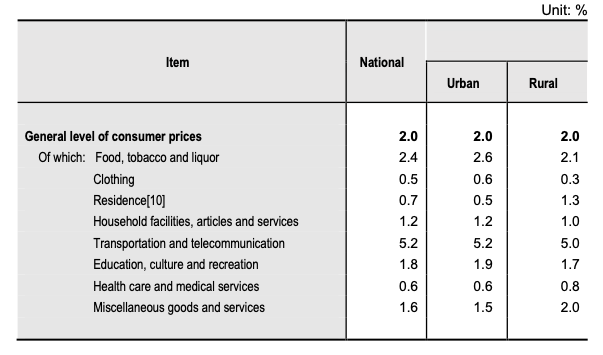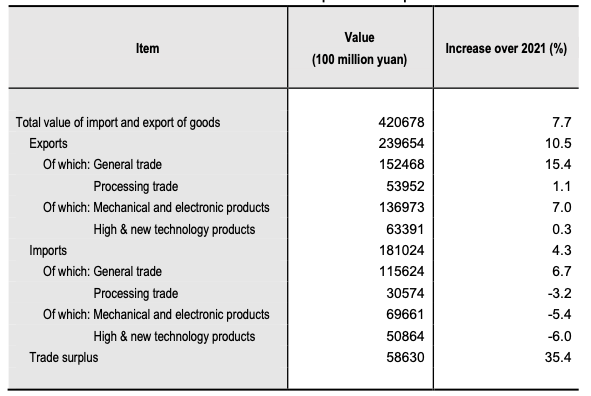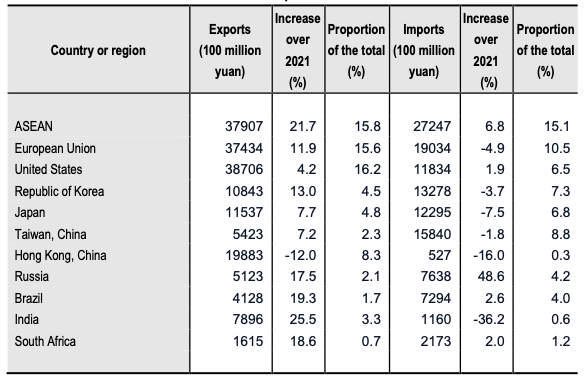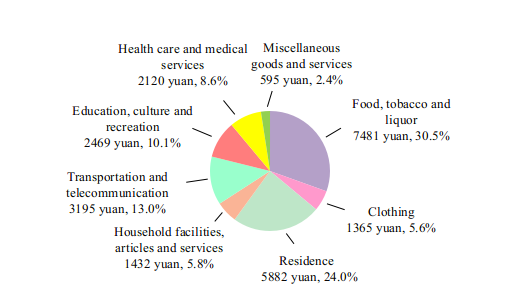Original from: National Bureau of Statistics of China, February 28, 2023
The year 2022 is a year of great importance in the history of the Communist Party of China (CPC) and the People’s Republic of China. The 20th National Congress of the Communist Party of China was successfully held, outlining a grand blueprint for building a modern socialist country in all respects and advancing the great rejuvenation of the Chinese nation on all fronts through a Chinese path to modernization. Confronted with challenges of high wind and choppy waters in the global environment as well as arduous tasks to advance reform, promote development and maintain stability at home, under the strong leadership of the CPC Central Committee with Comrade Xi Jinping at its core, all regions and departments took Xi Jinping Thought on Socialism with Chinese Characteristics for a New Era as the guideline, fully implemented the decisions and arrangements made by the CPC Central Committee and the State Council, considered both domestic and external situations in a coordinative way, coordinated the work of Covid-19 prevention and control with economic and social development, and ensured both development and security. All regions and departments adhered to the general working guideline of making progress while maintaining stability, applied the new development philosophy in full, in the right way and in all fields of endeavor, accelerated efforts to create a new pattern of development, strove to promote high-quality development, and intensified efforts on macro control. The economy withstood impacts from factors beyond expectation, sustained growth and made steady improvement in development quality. Innovation-driven development was further promoted, and reform and opening-up was pursued at swift and steady pace. The employment and prices were generally stable, and the food and energy security as well as people’s livelihood was effectively safeguarded. The overall economic and social stability were achieved and solid strides were taken on a new journey to build a modern socialist country in all respects.
I. General Outlook
According to preliminary estimation, the gross domestic product (GDP)[2] in 2022 was 121,020.7 billion yuan, up by 3.0 percent over the previous year. Of this total, the value added of the primary industry was 8,834.5 billion yuan, up by 4.1 percent over the previous year, that of the secondary industry was 48,316.4 billion yuan, up by 3.8 percent and that of the tertiary industry was 63,869.8 billion yuan, up by 2.3 percent. The value added of the primary industry accounted for 7.3 percent of the GDP; that of the secondary industry accounted for 39.9 percent; and that of the tertiary industry accounted for 52.8 percent. The contribution of the final consumption expenditure to GDP growth rate was up by 1.0 percentage point, that of the gross capital formation to GDP growth rate up by 1.5 percentage points and that of the net exports of goods and services to GDP growth rate up by 0.5 percentage points. The per capita GDP in 2022 was 85,698 yuan, up by 3.0 percent over the previous year. The gross national income[3] in 2022 was 119,721.5 billion yuan, up by 2.8 percent over the previous year.
Figure 1: Gross Domestic Product and Growth Rates 2018-2022

Figure 2: Shares of the Three Industries’ Value Added in GDP 2018-2022


The consumer prices in 2022 went up by 2.0 percent over the previous year. The producer prices for industrial products went up by 4.1 percent and the purchasing prices for industrial producers up by 6.1 percent. The producer prices for farm products[9] grew up by 0.4 percent.
Figure 5:Monthly Changes of Consumer Prices in 2022



New industries, new forms and models of business grew fast. Among the industries above the designated size, the value added of the high technology manufacturing industry[11] increased by 7.4 percent over the previous year, accounting for 15.5 percent of that of all industrial enterprises above the designated size. The value added for the manufacture of equipment[12] was up by 5.6 percent, accounting for 31.8 percent of that of all industrial enterprises above the designated size. Among the service enterprises above the designated size[13], the business revenue of the strategic emerging service industries[14] went up by 4.8 percent compared with the previous year. In 2022, the investment in high technology industries[15] increased by 18.9 percent over the previous year. In 2022, the output of new energy vehicles reached 7.003 million, up by 90.5 percent over the previous year; and that of solar cells (photovoltaic cells) was 0.34 billion kilowatts, up by 46.8 percent. In 2022, the e-commerce transactions[16] reached 43,829.9 billion yuan, up by 3.5 percent over the previous year on comparable basis. The online retail sales[17] in 2022 reached 13,785.3 billion yuan, up by 4.0 percent over the previous year on comparable basis.
VII. Foreign Economic Relations
The total value of imports and exports of goods in 2022 reached 42,067.8 billion yuan, up by 7.7 percent over that of the previous year. Of this total, the value of goods exported was 23,965.4 billion yuan, up by 10.5 percent; the value of goods imported was 18,102.4 billion yuan, up by 4.3 percent. The surplus of trade in goods reached 5,863.0 billion yuan, up by 1,533.0 billion yuan over that of the previous year. The total value of imports and exports between China and countries along the Belt and Road[40] was 13,833.9 billion yuan, an increase of 19.4 percent over that of the previous year. Of this total, the value of goods exported was 7,887.7 billion yuan, up by 20.0 percent; the value of goods imported was 5,946.1 billion yuan, up by 18.7 percent. The total value of imports and exports between China and other Regional Comprehensive Economic Partnership (RCEP) member countries[41] was 12,949.9 billion yuan, up by 7.5 percent over that of the previous year.
Figure 16: Total Value of Imports and Exports of Goods 2018-2022

Table 9: Total Value and Growth Rates of Imports and Exports of Goods in 2022

Table 12: Imports and Exports of Goods by Major Countries and Regions, the Growth Rates and Proportions in 2022


IX. Households Income and Consumption and Social Security
In 2022, the per capita disposable income nationwide was 36,883 yuan, an increase of 5.0 percent over that of the previous year or a real increase of 2.9 percent after deducting price factors. The median[51] of per capita disposable income nationwide was 31,370 yuan, up by 4.7 percent. In terms of usual residence, the per capita disposable income of urban households was 49,283 yuan, up by 3.9 percent over that of 2021, or a real growth of 1.9 percent after deducting price factors. The median of per capita disposable income of urban households was 45,123 yuan, up by 3.7 percent. The per capita disposable income of rural households was 20,133 yuan, up by 6.3 percent over that of the previous year, or 4.2 percent in real terms after deducting price factors. The median of per capita disposable income of rural households was 17,734 yuan, up by 4.9 percent. The urban-rural per capita disposable income ratio was 2.45, narrowed by 0.05 over that of the previous year.
The national per capita consumption expenditure was 24,538 yuan, up by 1.8 percent over that of the previous year, or a real decrease of 0.2 percent after deducting price factors. Specifically, the per capita consumption expenditure on services[54] totaled 10,590 yuan, down by 0.5 percent over that of the previous year, accounting for 43.2 percent of the per capita consumption expenditure. In terms of usual residence, the per capita consumption expenditure of urban households was 30,391 yuan, up by 0.3 percent, or down by 1.7 percent in real terms after deducting price factors. The per capita consumption expenditure of rural households was 16,632 yuan, up by 4.5 percent, or a real increase of 2.5 percent after deducting price factors. The national Engel’s Coefficient stood at 30.5 percent, with that of urban and rural households standing at 29.5 percent and 33.0 percent respectively.
Figure 18: National Per Capita Disposable Income and Its Growth Rates 2018-2022

Figure 19: National Per Capita Consumption Expenditure and Composition in 2022


XI. Culture and Tourism, Public Health and Sports
By the end of 2022, there were 1,033,000 medical and health institutions in China, including 37,000 hospitals. Of all the hospitals, 12,000 were public, and 25,000 were private. Of the 980,000 medical and health institutions at grass-root level, there were 34,000 town and township health centers, 36,000 community health service centers, 321,000 clinics and 588,000 village clinics. Of the 13,000 professional public health institutions, 3,385 were disease control and prevention centers and 2,796 were health monitoring institutions. By the end of 2022, there were 11.55 million medical technical personnel in China, including 4.40 million licensed doctors and licensed assistant doctors and 5.20 million registered nurses. The medical and health institutions in China possessed 9.75 million beds, of which hospitals possessed 7.66 million and township health centers had 1.45 million. The total number of medical visits[70] and hospital discharges[71] in 2022 reached 8.40 billion and 250 million respectively.
Figure 23: Year-end Number of Medical Technical Personnel 2018-2022



Copyright © 2025 GL events Ruihe (Shanghai) Exhibition Co., Ltd. All Rights Reserved. ( 沪ICP备12004745号-1 )

We deliver the latest IVD news straight to your inbox. Stay in touch with CACLP News.
sign-up for our newsletter today.



To ensure our newsletter hit your inbox, make sure to add @caclp.com to your safe senders list. And, as always, feel free to contact
us with any questions and thanks again for subscribing.
 Go back
Go back
